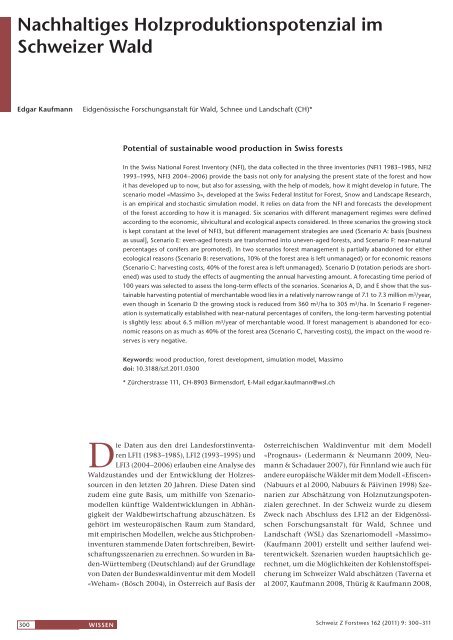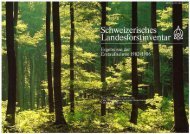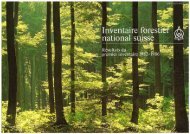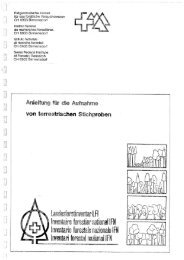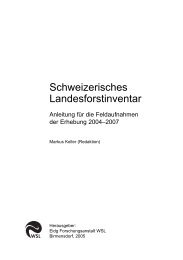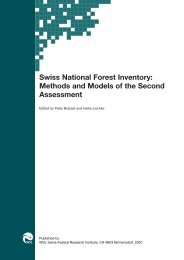30 Jahre Schweizerisches Landesforstinventar - LFI
30 Jahre Schweizerisches Landesforstinventar - LFI
30 Jahre Schweizerisches Landesforstinventar - LFI
Erfolgreiche ePaper selbst erstellen
Machen Sie aus Ihren PDF Publikationen ein blätterbares Flipbook mit unserer einzigartigen Google optimierten e-Paper Software.
nachhaltiges Holzproduktionspotenzial im<br />
schweizer wald<br />
edgar Kaufmann<br />
Eidgenössische Forschungsanstalt für Wald, Schnee und Landschaft (CH)*<br />
Potential of sustainable wood production in swiss forests<br />
In the Swiss National Forest Inventory (NFI), the data collected in the three inventories (NFI1 1983–1985, NFI2<br />
1993–1995, NFI3 2004–2006) provide the basis not only for analysing the present state of the forest and how<br />
it has developed up to now, but also for assessing, with the help of models, how it might develop in future. The<br />
scenario model «Massimo 3», developed at the Swiss Federal Institut for Forest, Snow and Landscape Research,<br />
is an empirical and stochastic simulation model. It relies on data from the NFI and forecasts the development<br />
of the forest according to how it is managed. Six scenarios with different management regimes were defined<br />
according to the economic, silvicultural and ecological aspects considered. In three scenarios the growing stock<br />
is kept constant at the level of NFI3, but different management strategies are used (Scenario A: basis [business<br />
as usual], Scenario E: even-aged forests are transformed into uneven-aged forests, and Scenario F: near-natural<br />
percentages of conifers are promoted). In two scenarios forest management is partially abandoned for either<br />
ecological reasons (Scenario B: reservations, 10% of the forest area is left unmanaged) or for economic reasons<br />
(Scenario C: harvesting costs, 40% of the forest area is left unmanaged). Scenario D (rotation periods are shortened)<br />
was used to study the effects of augmenting the annual harvesting amount. A forecasting time period of<br />
100 years was selected to assess the long-term effects of the scenarios. Scenarios A, D, and E show that the sustainable<br />
harvesting potential of merchantable wood lies in a relatively narrow range of 7.1 to 7.3 million m 3 /year,<br />
even though in Scenario D the growing stock is reduced from 360 m 3 /ha to <strong>30</strong>5 m 3 /ha. In Scenario F regeneration<br />
is systematically established with near-natural percentages of conifers, the long-term harvesting potential<br />
is slightly less: about 6.5 million m 3 /year of merchantable wood. If forest management is abandoned for economic<br />
reasons on as much as 40% of the forest area (Scenario C, harvesting costs), the impact on the wood reserves<br />
is very negative.<br />
Keywords: wood production, forest development, simulation model, Massimo<br />
doi: 10.3188/szf.2011.0<strong>30</strong>0<br />
* Zürcherstrasse 111, CH-8903 Birmensdorf, E-Mail edgar.kaufmann@wsl.ch<br />
Die Daten aus den drei <strong>Landesforstinventar</strong>en<br />
<strong>LFI</strong>1 (1983–1985), <strong>LFI</strong>2 (1993–1995) und<br />
<strong>LFI</strong>3 (2004–2006) erlauben eine Analyse des<br />
Waldzustandes und der Entwicklung der Holzressourcen<br />
in den letzten 20 <strong>Jahre</strong>n. Diese Daten sind<br />
zudem eine gute Basis, um mithilfe von Szenariomodellen<br />
künftige Waldentwicklungen in Abhängigkeit<br />
der Waldbewirtschaftung abzuschätzen. Es<br />
gehört im westeuropäischen Raum zum Standard,<br />
mit empirischen Modellen, welche aus Stichprobeninventuren<br />
stammende Daten fortschreiben, Bewirtschaftungsszenarien<br />
zu errechnen. So wurden in BadenWürttemberg<br />
(Deutschland) auf der Grundlage<br />
von Daten der Bundeswaldinventur mit dem Modell<br />
«Weham» (Bösch 2004), in Österreich auf Basis der<br />
österreichischen Waldinventur mit dem Modell<br />
«Prognaus» (Ledermann & Neumann 2009, Neumann<br />
& Schadauer 2007), für Finnland wie auch für<br />
andere europäische Wälder mit dem Modell «Efiscen»<br />
(Nabuurs et al 2000, Nabuurs & Päivinen 1998) Szenarien<br />
zur Abschätzung von Holznutzungspotenzialen<br />
gerechnet. In der Schweiz wurde zu diesem<br />
Zweck nach Abschluss des <strong>LFI</strong>2 an der Eidgenössischen<br />
Forschungsanstalt für Wald, Schnee und<br />
Landschaft (WSL) das Szenariomodell «Massimo»<br />
(Kaufmann 2001) erstellt und seither laufend weiterentwickelt.<br />
Szenarien wurden hauptsächlich gerechnet,<br />
um die Möglichkeiten der Kohlenstoffspeicherung<br />
im Schweizer Wald abschätzen (Taverna et<br />
al 2007, Kaufmann 2008, Thürig & Kaufmann 2008,<br />
<strong>30</strong>0 wissen Schweiz Z Forstwes 162 (2011) 9: <strong>30</strong>0–311


